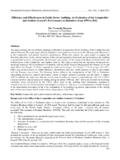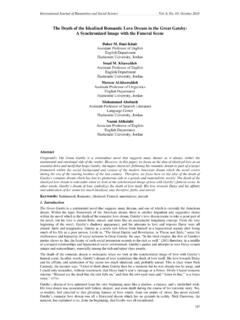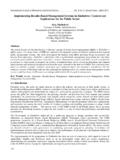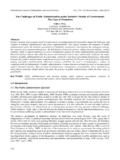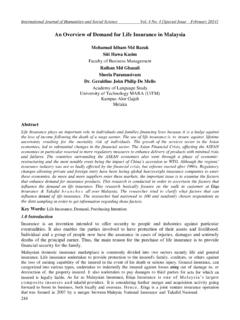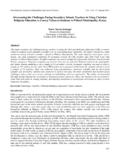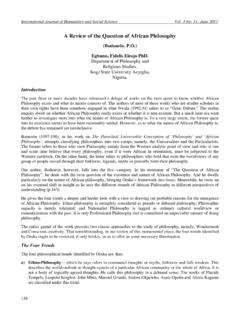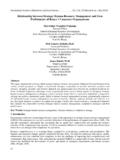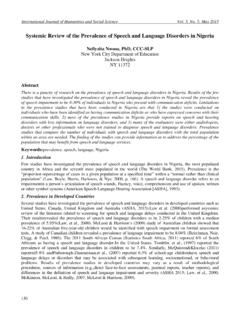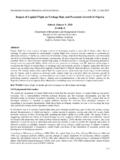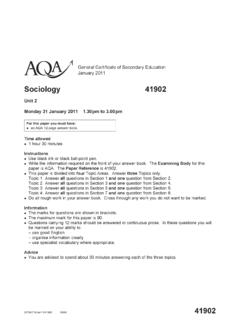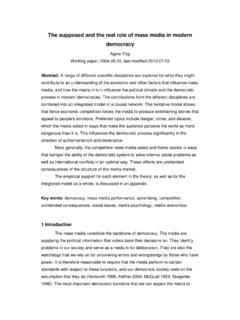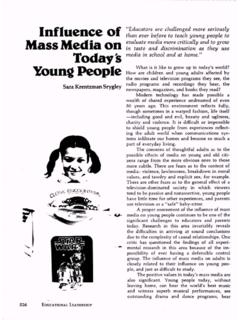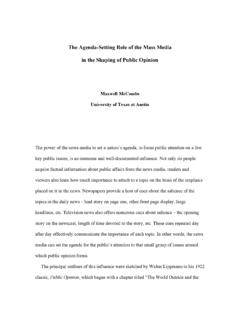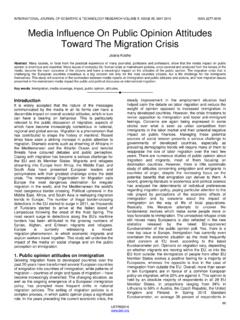Transcription of Factors that Influence Effective Communication of the ...
1 International Journal of Humanities and Social Science Vol. 5, No. 4; April 2015 172 Factors that Influence Effective Communication of the Youth Enterprise Development Fund to the Youth in Kabianga Division, Kericho County, Kenya Chepngeno B. Judy University of Kabianga Box 2030-20200, Kericho Kenya Biwott Edith Jelagat (Corresponding Author) Phd Student, Department of Communication Studies, Moi University Box 7536-30100, Eldoret Kenya Abstract Information provision facilitates development in any country. The government should, therefore, ensure that policies are communicated well so that the target audience is reached and the objective Paper sought to find out the Factors that Influence Effective Communication of the Youth Enterprise Development Fund (YEDF) to the youth in rural areas.
2 The study was carried out in Kabianga division of Kericho County. The study targeted all youth within the age bracket of 18-35 years in Kabianga division. A total of 210 respondents participated in the study. The main tool of data collection was survey-questionnaires for statistical analysis. However, key informant interviews and focus group discussions were used to complement with qualitative data. Lack of access to media, unavailability to use media, individual s educational level, language used in dissemination were some of the major Factors hindering Effective Communication to the youth in rural areas. Other Factors that influenced adoption of innovations were personal characteristics. It was concluded that the youth who had received the information and acted upon it by forming youth groups were: educated, of low socio-economic status, had a more favourable attitude, willing to take risks, had higher exposure to the outside world among others.
3 From the study findings, the paper recommends that the government should establish infrastructures in the rural areas to make these resources easily accessible to the people. Keywords: Effective , Communication , Youth Enterprise Development Fund, Kericho, Kenya 1. Introduction Governments all over the world are facing growing problems of organizing national programmes that can cater for the needs of young people to enable them to participate effectively in national development (IMF report, 2007). Many sessional papers that have tried to articulate strategies of poverty eradication have not targeted the youth and yet they also need employment opportunities, training and basic necessities of life. A report by UNSNRDFS (1997) points out that more than 850 million people in developing countries are excluded from a wide range of information and knowledge, with the rural poor in particular remaining isolated from both traditional and new information and Communication technologies which would improve their livelihoods.
4 One characteristic of rural areas, especially in Kenya, is lack of knowledge. This is partly why targeting the youth can succeed if the ways of Communication are carefully chosen, if the youth are empowered with the skills and their enterprises monitored for regular guidance. Murugu (2008) states that the youth are the most socially active and energetic segment of the population fully endowed with creativity and dynamism in any society. The population age bracket of 30 years and below, constitutes about 75 percent of the Kenyan population and 67 percent of the unemployed are the youth. In Kenya, the government launched the Youth Enterprise Development Fund to help spur entrepreneurial culture among the youth so that many of them could embrace and join the micro and small enterprise sector and subsequently, stimulate economic growth.
5 ISSN 2220-8488 (Print), 2221-0989 (Online) Center for Promoting Ideas, USA 173 The Kenya Entrepreneurship Empowerment Foundation (2007) report, states that the purpose of the fund is to increase young entrepreneurs access to loans rather than increasing the supply of loan funds. However, with the development of YEDF, most youth have not actively taken part in it. The inability to acquire information by the rural population is attributed to the problem of information dissemination as the rural youth is composed of both literates and illiterates. Information provision facilitates development in any country. The government should, therefore, ensure that policies are communicated well so that the target audience is reached and the objective achieved.
6 In many occasions, the government utilizes one-way Communication process where messages are transmitted from policymakers to the general public using linear Communication channels. The assumption is that information will be received uniformly by all people. This is not usually the case in that information impacts differently on people because of differences in status, gender, age, location, educational status and access. Some may not even receive it at all due to limited economic and social opportunities. In some cases the government uses special Communication media like sessional papers, which have to be purchased from only one outlet in the country (government printer). It also uses Kenya gazette, which is a special Communication medium for government policy; paid for announcements in electronic and print media, posters and extension services through Barazas among others.
7 The question is whether the government is aware of the dynamics of the channels used to communicate its policies. This paper thus seeks to find out the Factors that Influence Effective Communication of the YEDF to the youth in the rural areas of Kabianga Division in Kericho County. 2. Materials and Methods This study employed descriptive cross-sectional research design. It was carried out in Kabianga division of Kericho County. The study targeted all youth within the age bracket of 18-35 years in Kabianga division. This age bracket was chosen since they were the group entitled to get the Youth Enterprise Development Fund according to the then Ministry of Youth Affairs. Using purposive sampling, 3 sub-locations which have poor roads and Communication network system were chosen out of the 15 sub-locations in the division.
8 From the 3 sub-locations chosen, convenient sampling was used to obtain 70 respondents making a total sample size of 210. The main tool of data collection was survey-questionnaires for statistical analysis. However, Key informant interviews and focus group discussions were used to complement with qualitative data. 3. Findings and Discussions Marital Status of the Respondents In the study, 120 respondents ( ) were single while 90 respondents ( ) were married. This is shown in figure 1. Figure 1: Pie Chart Showing Respondents Marital Status As shown in figure 1, there was a high representation of the singles in comparison with the married. The singles, who were mostly younger, were more willing to participate in the study. They were observed to be interested in matters concerning youth thus could be involved in issues affecting them.
9 International Journal of Humanities and Social Science Vol. 5, No. 4; April 2015 174 Most of the singles interviewed claimed that they received Youth Fund information through their peers. The married on the other hand interpreted the term youth to mean unmarried man or woman such that they claimed they no longer belonged to that category (youth) therefore they showed little interest in participating in the study. Effective Communication by the use of appropriate channels would have served to clear such misconceptions and more would have likely been involved in joining youth groups for the purposes of applying for YEDF. Educational Level of the Respondents Education level was considered in order to determine the literacy level of the respondents.
10 It was noted that the highest level of formal education of the respondents was secondary education with 101 ( ) cases. This was followed by post secondary college/polytechnic level education 76 ( ). Those who had primary level education were 19 (9%), while only 14 ( ) had attained university level education. This is presented in figure 2. Figure 2: Bar Graph Showing Respondents Educational Level It is evident from the graph that the sample drawn from the population of the study was fairly educated thus, literate. Accessing and utilizing information obtained to a large extent depends on one s educational level. Chalmers (1995) posits that education has a bearing in the ability to identify and use Communication resources. The more educated one is, the better placed he or she is to seek and utilize these resources.
